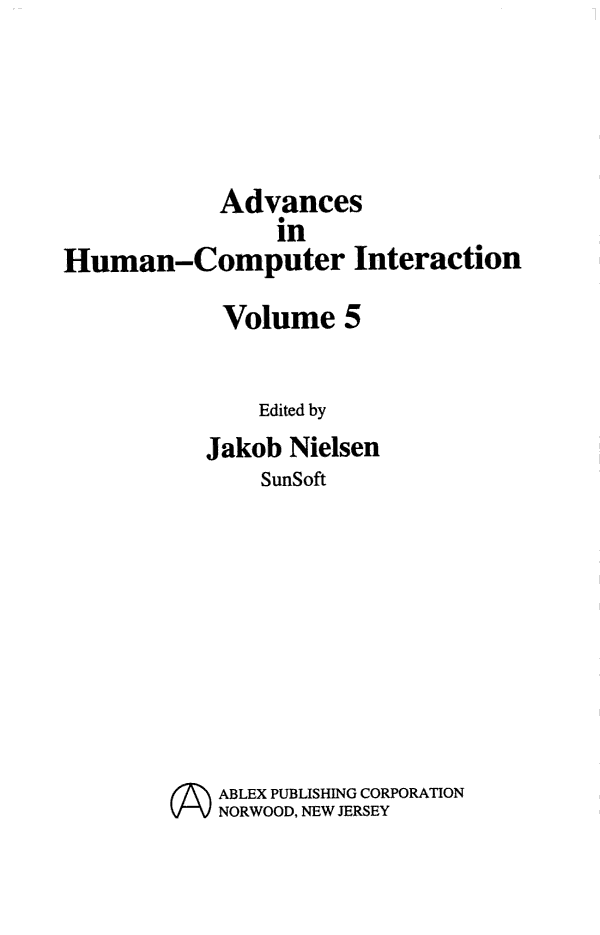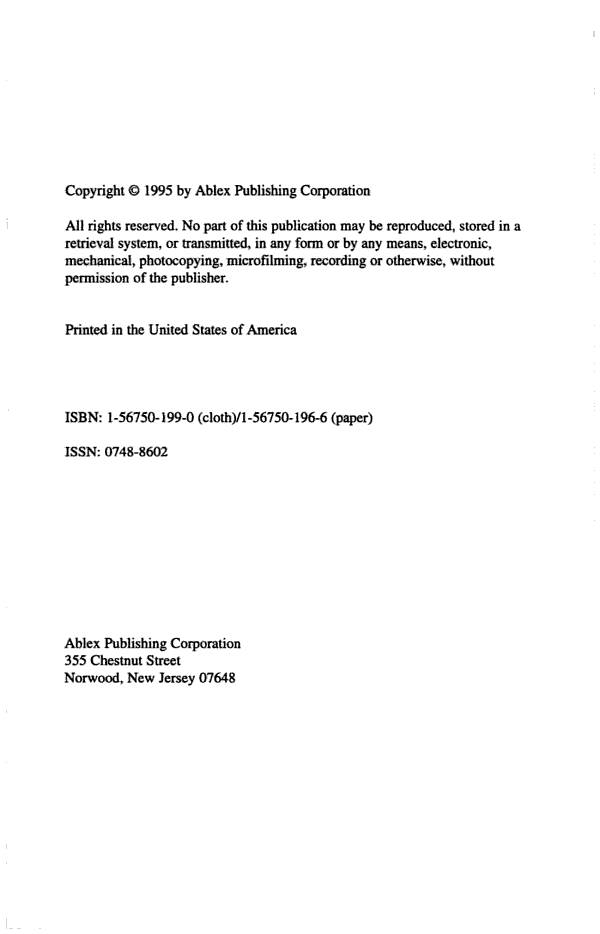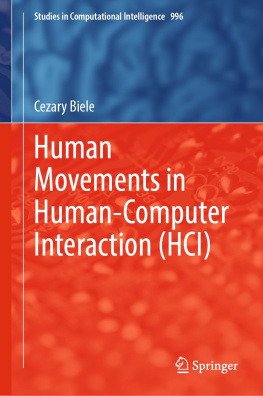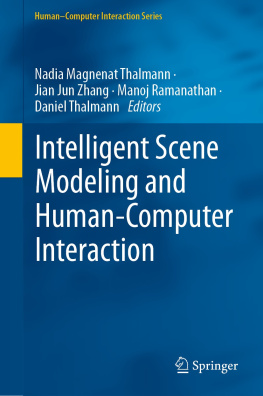Jakob Nielsen - Advances in Human-computer Interaction
Here you can read online Jakob Nielsen - Advances in Human-computer Interaction full text of the book (entire story) in english for free. Download pdf and epub, get meaning, cover and reviews about this ebook. publisher: Ablex Publishing Corporation, genre: Computer. Description of the work, (preface) as well as reviews are available. Best literature library LitArk.com created for fans of good reading and offers a wide selection of genres:
Romance novel
Science fiction
Adventure
Detective
Science
History
Home and family
Prose
Art
Politics
Computer
Non-fiction
Religion
Business
Children
Humor
Choose a favorite category and find really read worthwhile books. Enjoy immersion in the world of imagination, feel the emotions of the characters or learn something new for yourself, make an fascinating discovery.

- Book:Advances in Human-computer Interaction
- Author:
- Publisher:Ablex Publishing Corporation
- Genre:
- Rating:4 / 5
- Favourites:Add to favourites
- Your mark:
- 80
- 1
- 2
- 3
- 4
- 5
Advances in Human-computer Interaction: summary, description and annotation
We offer to read an annotation, description, summary or preface (depends on what the author of the book "Advances in Human-computer Interaction" wrote himself). If you haven't found the necessary information about the book — write in the comments, we will try to find it.
Advances in Human-computer Interaction — read online for free the complete book (whole text) full work
Below is the text of the book, divided by pages. System saving the place of the last page read, allows you to conveniently read the book "Advances in Human-computer Interaction" online for free, without having to search again every time where you left off. Put a bookmark, and you can go to the page where you finished reading at any time.
Font size:
Interval:
Bookmark:

Editorial Board
John M. Carroll, Virginia Polytechnic Institute and State University
Kate Ehrlich, Lotus Development Corporation
Steven Feiner, Columbia University
James D. Foley, Georgia Institute of Technology
Jim Hollan. University of New Mexico
Wendy A. Kellogg, IBM T. J. Watson Research Center
Robert E. Kraut, Carnegie Mellon University
Gitte Lindgaard. Telecom Australia Research Laboratories
Allan MacLean. Rank Xerox Research Centre, Cambridge, England
Thomas W. Malone, MIT Sloan School of Management
Marilyn Mantei. University of Toronto
Tim Oren. CompuServe
Janice Anne Rohn, SunSoft
Gitta Salomon, IDEO Product Design
Chris Schmandt, MIT Media Lab
Gurminder Singh, National University of Singapore
Gillian Crampton Smith, Royal College of Art, England
Akikazu Takeuchi, Sony Computer Science Laboratory, Japan
Tandy Trower, Microsoft
Hirotada Ueda, Hitachi Central Research Laboratory, Japan
Patricia Wright, MRC Applied Psychology Unit, England
Juergen Ziegler, Fraunhofer Institute IAO, Germany


Preface
Gary Perlman at the Ohio State University maintains a very useful online bibliography of most of the books and papers published in the human-computer interaction (HCI) field. HCI is usually recognized as having started as a separate field in 1982 with the first major conference, and Perlman's bibliography contains 215 entries for that year. For 1993 (the latest year for which full statistics are available), the HCI bibliography contains 2043 entries. In other words, the literature in the HCI field has grown by a factor of 10 in just 11 years.
One may view the explosive growth of the HCI literature as a sign of the health of the field. Indeed, there are ever more conferences, journals, and books published, and the comp.human-factors newsgroup on the Internet adds about 40% in new subscribers every year. At the same time, the information explosion means that practitioners in the HCI field have become unable to keep up with the literature. Even researchers who need to read other research papers as a part of their job cannot keep up with the literature outside of their own narrow field of expertise. Even in 1982 I doubt that anybody read all 215 HCI papers, but it would at least have been physically possible to do so and maintain a renaissance-like awareness of the complete field.
As editor of the Advances in HCI I have decided to use this series to try to fight the information overload problem for HCI specialists. We will concentrate on two types of chapters: those that survey an important area within HCI and provide an overview of recent advances, and those that survey interesting specific design or development projects to show how the state of the art in HCI is actually being carried out. A third category will receive less emphasis with one or two chapters in each volume: futuristic, historic, or personal essays by leading HCI specialists who speculate on important trends in the field.
Chapters 1-4 fall into the category of surveys of important subfields of HCI. First, Kellogg and Richards survey the human factors of information on the Internet. The Internet has received so much press coverage in the last two years that I am sure everybody knows what it is. Interestingly, most newspaper articles about the Internet include some statement lamenting the "cryptic commands and codes" necessary to use it. A first, naive, analysis might lead one to believe that graphical user interfaces would solve this problem by hiding the command names from the user. But as most HCI specialists know, GUIs can have usability problems too, especially when they are retrofitted onto a system with problematic semantics. Thus, would-be developers of the "information superhighway" would be well advised to read (and heed) chapter 1.
Chapters 2 and 3 survey current hot user interface technologies. Bederson and Druin discuss computer-augmented environments, which are a somewhat different take on enhanced interactions than virtual reality with its cumbersome helmets. In chapter 3, Isbister and Layton survey the use of agents as another way of enriching the user's experience compared with the tedious sequence of commands needed in traditional systems. I particularly want to highlight the subtitle of Bederson and Drum's chapter, "New Places to Learn, Work, and Play." All three applications of computers are important for HCI and all can benefit from increased attention to usability. Indeed, because the majority of computer sales now go into the home, home computing, entertainment interfaces, and children's interfaces will probably dominate in the future. Most HCI work (including, admittedly, much of this book) still focuses on use of computers in the workplace, but designing good interfaces for shooting aliens in videogames will soon become a bigger business than designing good interfaces for shooting Soviets for the Defense Department. Even people who prefer nonviolent games probably agree that this is a positive development.
The most classic trap in user interface design is to assume that the user is like yourself. Because most developers (at least so far) have tended to be young, mathematically inclined hotshots, there are definite dangers to this assumption. To increase the sales of computers to a broader audience than other hackers, we have to design with the customers' characteristics in mind. One important market consists of disabled users and Bergman and Johnson discuss ways of making computers more accessible to these customers in chapter 4.
Chapters 5-7 belong to the second category of project reports. In chapter 5, Hunter describes a project at Hewlett Packard to design a pen-based interface to a groupware system, thus combining two important subfields of HCI. The fact that interesting systems like the one described by Hunter invariably draws from multiple fields is an important lesson that should cause some reflection in this age of specialization. Multidisciplinarity is a traditional concern of human factors people, and both Graham and Dye and Turner, Lee, and Atwood comment on the collaboration between usability specialists and developers in their chapters. Graham and Dye describe ways of using information about user needs in the design of Microsoft applications that typically reach a very large market of diverse users and Turner, Lee, and Atwood describe usability work on a much more narrow (but economically important) system for NYNEX telephone company operators. It is instructive to compare these two chapters and their lessons with respect to usability needs for the two main types of software development: sale on the open market and in-house use. A general observation across all three project report chapters is that results, methods, and concepts from HCI research influenced the development of real systems. One often hears HCI researchers complain that system development disregards the research in the field. Of course, it is true that no HCI practitioner can read even a small fraction of the 2043 papers and books published in a year, and it is also true that lack of infrastructure and other practical constraints keep many new technologies from being used in current products. However, the better and more relevant parts of HCI research definitely do not go to waste.
Font size:
Interval:
Bookmark:
Similar books «Advances in Human-computer Interaction»
Look at similar books to Advances in Human-computer Interaction. We have selected literature similar in name and meaning in the hope of providing readers with more options to find new, interesting, not yet read works.
Discussion, reviews of the book Advances in Human-computer Interaction and just readers' own opinions. Leave your comments, write what you think about the work, its meaning or the main characters. Specify what exactly you liked and what you didn't like, and why you think so.








